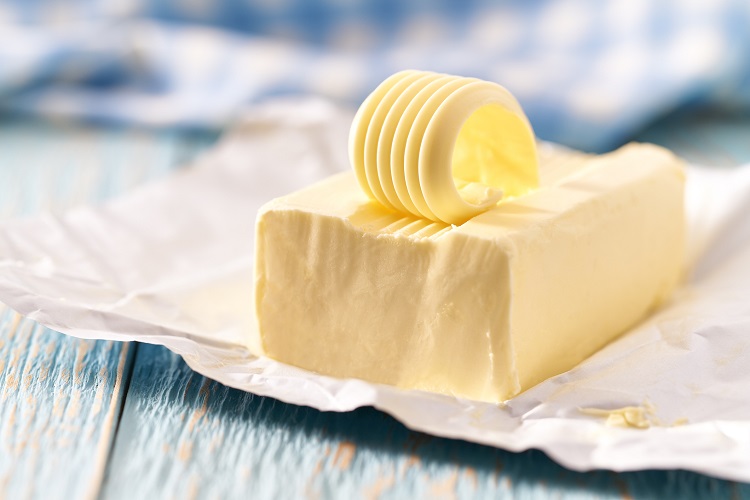From delicate puff pastry (Blätterteig) that shatters into buttery layers to moist, tender cakes that melt in your mouth, butter plays a starring role in some of our favorite baked goods. In fact, how you handle—and choose—your butter can make the difference between a baking masterpiece and a mediocre outcome. Ready to take your pastries and cakes to the next level? Let’s explore the science of butter in baking and how to harness its properties for flakier pastries and more tender cakes.
1. Why Butter Matters
Butter isn’t just a source of fat—it’s an emulsion containing about 80% fat, 16–18% water, and a small percentage of milk solids. This unique combination influences:
-
Texture: Butter’s fat coats flour particles, contributing to tenderness.
-
Flavor: That unmistakable richness and aroma come from the milk fat and solids.
-
Moisture and Steam: Water in butter turns into steam at high temperatures, creating air pockets for rise and flaky layers.
Whether you’re whipping up a classic German Blätterteig or baking a simple butter cake, understanding how butter behaves can help ensure top-notch results.
2. Blätterteig (Puff Pastry): Building Layers of Flakiness
2.1 The Laminated Dough Process
Traditional Blätterteig—also known as puff pastry—relies on lamination, the technique of folding butter into a dough multiple times. Each fold creates thin layers of dough separated by butter.
-
Basic Dough (Détrempe): A simple mixture of flour, water, and sometimes a touch of salt.
-
Enclosing the Butter: A slab of butter is placed onto the rolled-out dough, then folded like an envelope.
-
Repeating Folds: The dough is rolled out, folded, and chilled repeatedly, creating dozens (or hundreds!) of alternating butter and dough layers.
2.2 The Role of Butter in Puff Pastry
-
Steam for Lift: As the pastry bakes, the water in the butter evaporates into steam, pushing layers of dough apart and creating that signature “puff.”
-
Barrier Between Layers: The layer of butter separates one sheet of dough from the next, keeping them distinct and crisp.
2.3 Tips for Flakier Puff Pastry
-
Cold is Key: Keep both the dough and butter cold at every step; warm butter can ooze out and compromise the layers.
-
High-Quality Butter: European-style or high-fat butter often yields better lamination and flavor because of its lower moisture content and richer taste.
-
Minimal Handling: Overworking the dough can develop too much gluten, leading to tough pastry.
3. Butter’s Contribution to Tender Cakes
3.1 Creaming Method
Many cake recipes call for the creaming method, which involves beating butter and sugar together until light and fluffy. This step:
-
Incorporates Air: Small air bubbles get trapped in the butter, helping cakes rise and stay light.
-
Coats Flour Particles: The fat in butter coats flour once it’s added, reducing gluten development and resulting in a tender crumb.
3.2 Emulsifying Batter
When eggs and dry ingredients are incorporated, butter helps emulsify these components, ensuring a smooth batter. A well-emulsified batter leads to:
-
Consistent Texture: Fewer large pockets of air mean even rising.
-
Moist and Velvety: Properly mixed batter retains moisture and bakes more evenly.
3.3 Tips for Tender Cakes
-
Room Temperature Butter: It creams more effectively with sugar, incorporating air properly.
-
Don’t Overmix: Once you add flour, mix just until combined to avoid tough cakes.
-
Use Unsalted Butter: Gives you precise control over the recipe’s salt level and a purer butter taste.
4. Choosing the Right Butter for Baking
With so many butter options on the market, knowing which one to pick can be daunting. Here’s a quick guide:
-
European-Style Butter (82–85% fat): Great for puff pastry and laminated doughs due to lower moisture content and richer flavor.
-
Cultured Butter: Adds a subtle tanginess, which can benefit certain pastries and baked goods.
-
Regular (Sweet Cream) Butter (about 80% fat): A dependable, all-purpose choice for most cakes and general baking.
-
Salted vs. Unsalted: In baking, unsalted is preferred for controlling salt content precisely.
5. Mastering Temperature & Techniques
5.1 Keeping Pastry Dough Cool
For puff pastry or any laminated dough, temperature control is paramount:
-
Chill Between Folds: Fifteen to thirty minutes of rest in the fridge tightens the dough, making it easier to roll.
-
Work Quickly: Minimizing the time spent at room temperature helps maintain distinct layers.
5.2 Proper Mixing for Cakes
-
Cream Butter and Sugar Thoroughly: Aim for a pale yellow, fluffy mixture. This can take 3–5 minutes depending on your mixer.
-
Add Eggs Gradually: This helps maintain a stable emulsion.
-
Alternate Dry and Liquid Ingredients: Adding them in parts helps the batter stay smooth.
6. Troubleshooting Common Issues
-
Tough or Gummy Pastries: Often the result of butter melting into the dough or overhandling. Keep things cold and fold gently.
-
Dense Cakes: Could be due to under-creamed butter and sugar or overmixing after adding flour. Pay attention to mixing times and speed.
-
Greasy or Leaking Dough: Indicates butter was too warm during lamination or insufficient chilling between folds.
7. Bringing It All Together
When aiming for ultimate flakiness in puff pastries or dreamy tenderness in cakes, butter is your best friend. Its unique composition of fat and water creates steam in pastries and a tender crumb in cakes—so long as you respect its temperature needs and structural nuances. By selecting the right butter and using the correct techniques, you can elevate your baked goods from good to unforgettable.
Remember:
-
Keep pastry dough cold for distinct, flaky layers.
-
Cream butter thoroughly with sugar for light, fluffy cakes.
-
Choose high-quality butter to enhance both taste and texture.
With a bit of practice and attention to detail, you’ll be well on your way to producing pastries that rival your favorite bakery and cakes that taste like they came from a professional patisserie.

Comments (0)
No comments yet. Be the first to comment!